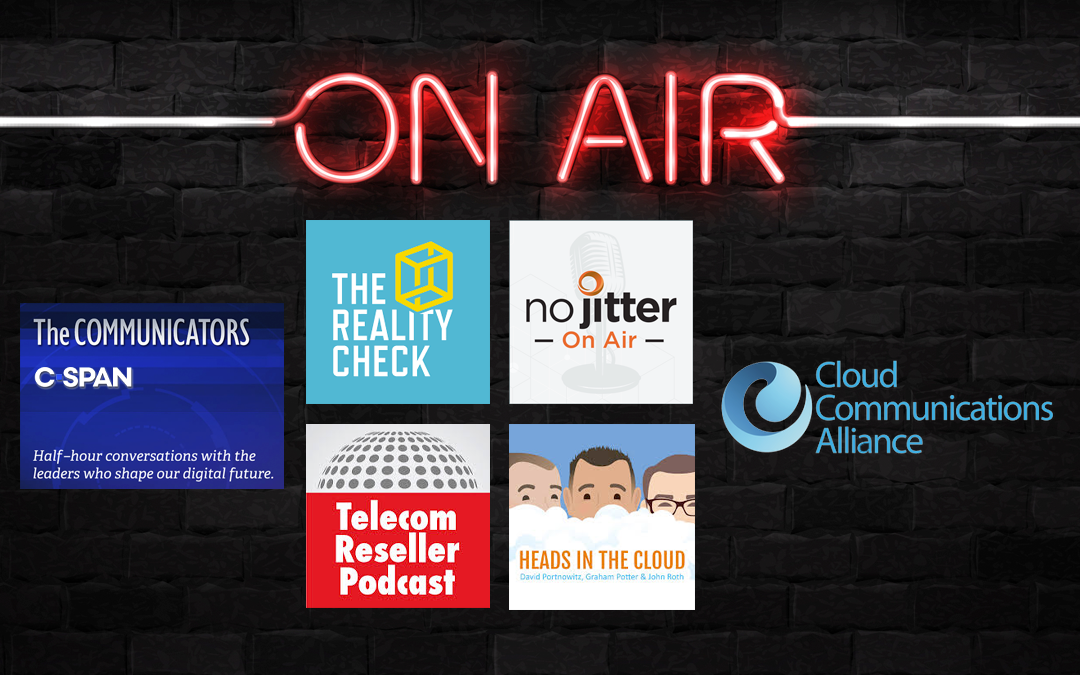Michael Tindall, thinQ/Commio Co-Founder & Chief Architect, Demos the Company’s Revolutionary Least Cost Routing (LCR) Engine
Toll-free calling may seem antiquated in an era of cheap unlimited calling plans. We tend to think of today’s phones as pocket computers meant to be tapped and swiped to communicate via text message rather than making a voice call.
Toll-free calling is still mission-critical to a majority of businesses, including:
- IT or contact center managers in charge of routing thousands of incoming and outgoing calls daily for internal and external customers
- App developers embed voice and text messaging into their Web or mobile applications
- Voice engineers at telecommunications companies, local carriers, and VoIP service providers
Until recently, toll-free calls were delivered through copper wires and hardware switches over single carriers like Verizon, AT&T, Level 3, CenturyLink, and others. Businesses and SaaS platforms alike (including Twilio) signed multi-year contracts, limiting their flexibility to route their calls through the least-cost routes, and when calls were being dropped or an outage occurred, their company’s communications went down–sometimes for hours or days.
Getting help from the carrier was a major challenge. Many times there were no humans to talk to, only ticketing systems to send in questions or concerns, with multi-day delays to get (or not get) a response.
Enter thinQ (pronounced “think”)
It’s every entrepreneur’s dream: identify a multi-billion dollar, stodgy (read: boring) industry that’s been underserved by modern, innovative technology. Challenge the incumbent players by providing a superior replacement product that lowers costs, delivers more flexibility, and nearly eliminates the chances of the product breaking when you need it the most. Then deliver superior customer service through a highly-trained support team who acts quickly and efficiently – with a smile.
thinQ (now Commio’s) co-founders, Aaron Leon (CEO) and Michael Tindall (Chief Architect), veterans of the telecom world, identified toll-free calling as an industry that was ripe for disruption.
The company’s cloud communications platform gives companies the ability to save money on every call by routing their calls over the Internet through multiple carriers, gaining reliability, flexibility, and automatic disaster recovery. Add a customer service team standing ready to answer partner questions, delivering support in minutes versus days, and you’ve got yourself a recipe for toll-free calling disruption with a human touch.
Meet Michael Tindall, Commio Co-Founder & Chief Architect
 For the last 20 years, Michael has made a career out of engineering disruptive communication technology.
For the last 20 years, Michael has made a career out of engineering disruptive communication technology.
He co-founded thinQ (now Commio) in 2009 after building one of the industry’s first cloud-based platforms to route voice calls over the Internet through the best-cost carriers and routes (known as Least Cost Routing or, simply, LCR).
Mike took time away from working with our development teams to discuss his innovative, first-of-its-kind technology that’s reinvented how contact centers, enterprise companies, and telecommunications providers manage their toll-free calling.
How did you arrive at the decision to develop this cloud-based technology to modernize toll-free call routing?
We’re in an industry that’s very antiquated in many regards, and my goal has always been to move technology forward to modernize voice communications. Today that means intelligent, cloud-based software that untethers companies from single carriers and rates that aren’t updated several times a month. Instead, the cloud and our platform gives you flexibility, cost savings, and reliability.
First a little bit about Commio, originally thinQ, founded in 2009 by myself and Aaron Leon. We were colleagues at Bandwidth, and after we were surveying the market we realized there was an opportunity to improve communication software using the power of the cloud.
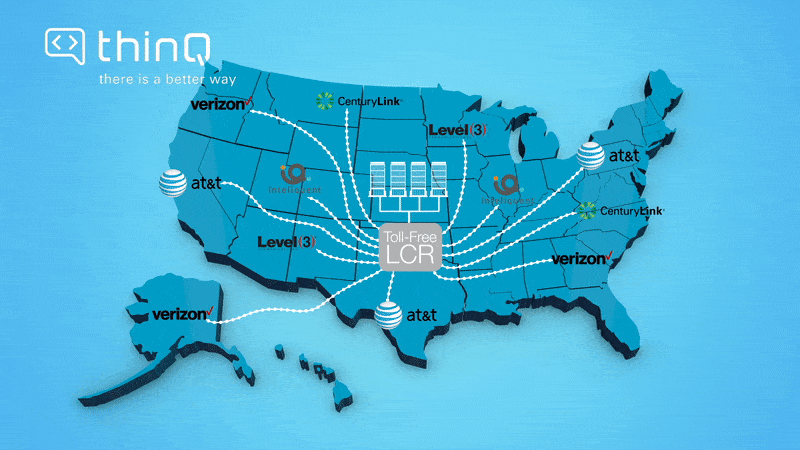
We built the industry’s first and only cloud-based, adaptive, Toll-Free Least Cost Routing platform. We also offer a variety of third-party voice APIs that allow our software to integrate with other communications platforms as a service (CPaaS) like Twilio, Plivo, Nexmo, and others.
We also have messaging (SMS/MMS) capabilities that allow customers to develop text messaging applications around their platforms. Plus, we have some data-feed services that are provided via API such as Caller ID Name (CNAM) and E911.
How big is the market for Cloud Communications as a Service (CPaaS) solutions?
Today the U.S. call center market is roughly $22 billion dollars and growing. And the global market may reach $407 billion in the next few years. Why is it growing so rapidly? First and foremost, companies have to keep up with increasingly complex customer experience demands.
Customers want to be able to reach you or your contact center whenever and however they want. In fact, it’s so important that Gartner reports roughly 89 percent of companies expect to compete mostly on the basis of customer experience in the coming years. This stands in stark contrast to just a few years ago when that number was 36 percent. That’s huge.
It’s no longer enough to simply have a good product. You have to have an excellent customer support experience to back it up. So this is not only leading to an increased investment in people, process, and training, but also to overhaul outdated technology and IT resources that simply are inadequate to meet these coming challenges. All of these investments are aimed at one thing, which is improving the overall customer experience while scaling for the future.
Many contact centers continue to avoid legacy technology and companies that don’t update their technology, they’re just going to fall behind.
How can today’s contact centers and enterprise businesses scale their communications for the future?
The answer is the Internet and the cloud. Gartner recently predicted that more than $1 trillion dollars in IT spending will shift to the cloud during the next five years, and that cloud computing is one of the most disruptive forces on IT spending since the early days of the digital age.
I don’t think there’s any point in belaboring that we all see what’s happening with other technologies moving online into the cloud. Again, legacy equipment technology like physical routers and switches are no longer sufficient to address the myriad of customer service and support requirements we’re all going to be faced with in the future.
Plus, even though there are these really cool technological advances in new customer touchpoints, 80 percent of people still prefer authentic human-to-human voice support over the phone. In fact, voice accounts for roughly 50 percent of all inbound support interactions.
This presents a huge opportunity for innovation, optimization, cost savings, and improving customer experience, which is what we’re going to discuss here.
How is technology changing toll-free calling, and what challenges are today’s contact centers facing?
If you own a toll-free line or support center, you’re probably paying a flat rate per minute fee on incoming toll-free calls regardless of where that caller is calling from. For any enterprise-level company, these costs can be staggering.
You know I’ve seen north of a penny or two pennies, sometimes even more if the contracts have been neglected and not renegotiated, per minute. Reducing this cost could let you reallocate the funds towards better training, technology, more people-focused around customer experience. There’s opportunities for improvement here. Furthermore, these flat-rate carrier agreements, they have to be negotiated at regular intervals. You sign a contract, you’ve got the rate, the supplier is not going to come to you and say “I’ve got this great new low rate.” If you want it, you’re going to have to call. You know it’s a frustrating process that sometimes doesn’t work out in your favor.
Lastly, even if you’re working with a great tier one provider, this doesn’t ensure that you’re getting the best connections to their origination points where your customers are calling from. You know this could result in static, drop calls, or even a full-scale carrier outage, which I have personally experienced in past lives.
Anybody who’s experienced an outage knows this drastically affects your reputation, customer retention, and overall experience. Add with the Internet and social media, it doesn’t take long for frustrated customers to let everybody know about it.
So we’ve developed a better way, which brings us to our Toll-Free LCR engine.
Could you give us a tour of thinQ’s Least Cost Routing engine and how it uses machine learning to route calls?
Sure. Now that we’ve got of an idea of what the platform does, let’s take a quick look and I’ll show you how it works. As we’ve discovered and as with many things the best way with pattern-based data to predict the future is to study the past. This is the basic principle behind our Toll-Free Least Cost Routing engine.
First, a quick definition check. A phone number is also known as a DID, which stands for Direct Inward Dialing.
North American phone numbers (called DIDs) follow this format:
NPA-NXX-XXXX
NPA is the 3-digit Numbering Plan Area (or NPA, also called Area Code)
NXX identifies the Central Office (or Exchange) within the NPA
XXXX identifies the Station in the NXX
So if we look at this DID (phone number):
(919) 890-0000
919 is the NPA
890 is the NXX
0000 identifies the Station in the NXX
When you connect toll-free numbers to thinQ, our AI-powered LCR engine programmatically analyzes past traffic patterns and prioritizes the top NPA and NXX locations that are calling your toll-free number to conduct a detailed pricing analysis. Our engine does this using machine learning algorithms that we’ve developed, think of it as artificial intelligence analyzing your recent call patterns. Every single customer’s optimization or experience is going to be different and tailored based on their traffic patterns and the changing traffic patterns. It’s not a static environment.
The engine analyzes and determines the most current carrier prices within an NPA and NXX, and then it selects the optimal carrier for each one of those originating locations. So after the optimal carrier is selected, the system will automatically update and route the calls over our incoming carrier network.
So let’s say it picks 919890 for Verizon and that ends up being the best route. For that code, anybody calling from that area is going to come in over the Verizon trunk into thinQ’s platform and then get routed to your network. This is iterated over and over for your top 30,000 NPA and NXXs.
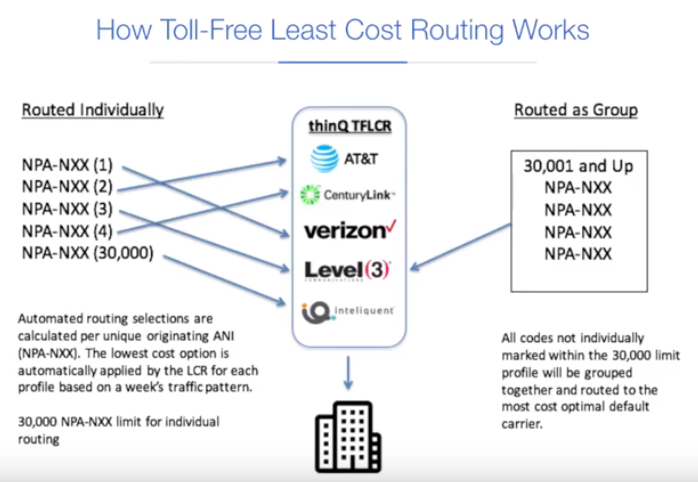
If you receive a call outside of one of these optimized locations, for example, a less-trafficked area, a rural area, or someplace that’s never even called you before, a default call routing profile is created. So it will fall into that default carrier, and that’s chosen by analyzing the remaining traffic as a whole and figuring out the best carrier for that pool of traffic.
These carrier selections are automatically re-optimized. So it’s not just going to stay there, if you get a new endpoint that’s calling you, yes, when they first call it will come in on the default carrier that’s selected based on the remaining un-optimized 30,000 rows. However, it’s not going stay there because we re-optimize every few days to account for changes in your calling volume.
This is how the system’s adaptive, finding the least cost route for your calls. Every few days it’s simply doing another look back, using the machine learning algorithm to figure out, “Am I still optimal or not optimal? If not optimal let’s make some changes.” And it does this without you having to do anything.
The location of your incoming calls is automatically detected and because we have this adaptive process it ensures that you always get the best price for your calls. You don’t have to call and renegotiate with any carrier. You don’t have to sit here and try to figure out how to do this yourself. You get maximum flexibility, access to more than 40 carriers, and savings of up to 70% on every call.
We all love to save on our toll-free calls. Routing our calls over multiple carriers sounds like a great way to almost eliminate the potential for downtime or outages, right?
I can’t tell you how many customers I’ve talked to said, “You know Mike, that’s great. You can save me costs. But not at the expense of my customer experience I need to have.” Agreed.
An excellent customer experience is critical. That’s why having a multiple carrier solution is so important, because what I’m about to show you will show you how we control the quality of the experience the customer.
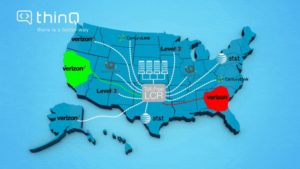 So a multiple carrier solution gives you more than just great rates. It also gives you disaster recovery in the event that there’s a potentially embarrassing carrier outage. So in this example you’re going to see an illustration going on here.
So a multiple carrier solution gives you more than just great rates. It also gives you disaster recovery in the event that there’s a potentially embarrassing carrier outage. So in this example you’re going to see an illustration going on here.
With multiple Tier 1 vendors already in the platform at your disposal you don’t have to sign contracts with them, it’s all done. Our system allows you to update your routing profiles in real time to mitigate downtime due to carrier outages. These could be regional or they could be global network-wide.
And this can be done by either removing a specific carrier from your routing profile, or by eliminating them from specific NPA and XXX codes. So once either the carrier has been removed or you’ve carved out a couple of NPA and XXX codes or regions that you’re not happy with, the LCR engine automatically recalculates and avoids the outage, only routing the calls over the active carrier routes that you’ve selected.
So having disaster recovery solutions is crucial if you want to maximize your uptime and keep your customers happy. Just recently, one our partners, a 24/7 answering service, experienced a pair of major carrier outages. As they said, this “left them completely dead in the water.” Fortunately, they were able to easily update their routing profile on thinQ to remove the offending carriers, and were back up and running in a matter of minutes.
Great story! Could you give us a quick tour of thinQ’s Least Cost Routing (LCR) platform?
Sure. This is our Toll-Free LCR dashboard. You can see that it’s going to have some business analytics data that shows you traffic, spend, duration of a period of time. As well as a couple of other metrics that I want to touch on. You can see our standard flat rates, this demo account only has a few calls on it. So it’s saving about 27 percent more or better than the flat rate.
Our partners see much better savings than this, ranging from 40% to 75% depending on their toll-free traffic. We also have some visualization tools that show heat maps of where calls are coming from, which is extremely powerful because you can see your traffic changing over time and you’ll see the system respond to it over time.
Everything in our engine is driven by what we call a routing profile and you can think of this as a configuration container that you throw numbers in. So I’ve got a few profiles set up.
I’m going to create a new one. And we’re going to call it Mike Test. I’m going to just go ahead and turn on all five carriers, and we’ll allow calls from the U.S. and Canada in this profile for toll-free. Save it. I don’t have any numbers in here so it’s not going to do anything. So to do that I go in here, I’ve got my demo number, it’s on a test profile. I want to change that over to the new profile I just created.
I can see my test has one number. We go into our log section, you’ll see there’s a pending action where I moved the number to this profile. However, it’s pending, it’s going to take a few minutes to accept those changes and confirm back to us that those changes are then alive and they’ll all turn into a green check mark.
Let’s talk about disaster recovery. Let’s say I’ve got a problem with one of my carriers. We’re going to remove Verizon from 919890 which is my NPA and XX here. I think this is going to be a short-term problem so I’m going to set an expiration date for this block and I’m not going to let it sit here forever.
Once I click save, the engine is going to say “OK, you don’t want Verizon taking these calls, so I have to figure out who the next best one is.” Basically eliminate them from that part your profile. Well let’s say, it’s a more sweeping issue. You know, it’s not just this one area and I don’t really want to sit here figure it out right now, I’m going to turn them off.
So I come in here and turn them off. Click save, and the system again will detect this change, automatically reoptimizing, where we can see right now it’s got four vendors in the profile, changes are now pending.
Once that goes green we’ve confirmed that everything’s good and everything’s been re-optimized based on eliminating this carrier. So now your customers are back up and running. You didn’t have to spend hours waiting for somebody to do something. You didn’t spend days with an outage. You’re back up and running. That’s true disaster recovery, and it’s in our hands with Commio.
What if something happens to your network or your systems? We have inbound routing profiles you assign to your toll-free traffic or your numbers. We allow you to define up to three incoming endpoints that we will attempt to send to you. So we’ve handled the vendor side, but now we’re saying what happens if your SBC goes down or your IVR or PBX or whatever you’re using and something happens, right?
You can define up to three, I’ll create an IP address, we’ll do a DNS record which also allows you to control some level of disaster recovery within your own DNS. And let’s just say ‘Hey I want to send it straight out native SIP to a SIPURI in one of our systems.
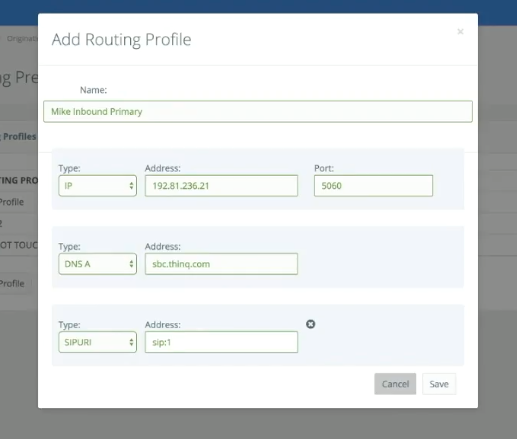
Once I save that, I can assign this to any one of my toll-free numbers or any number in the system. I can rearrange priorities. So let’s say, Ok, I don’t like this one anymore I want to use my A records first, I’ll move that up and then I’ll move the SIPURI to position number two. Once I press save that’s instantaneous, your calls now follow that inbound routing profile.
Mike, thanks for the tour. Could you sum up the advantages of using Commio’s Toll-Free Intelligent Call Routing (ICR) engine?
Yes, it all starts with moving away from a single-carrier solution to one that lets you choose multiple carriers. You simply pick the vendors you want to use, the system figures that out for you. You have a problem, take them out for a specific area and then again with inbound routing disaster recovery fail-over. Your system goes down, our systems are automatically going to detect it and then follow that prioritized routes set that you just saw me create. So now that you’ve seen the platform, let’s reiterate the advantages.
First you get instant access to multiple Tier 1 carriers without having to manage that process yourself. This automatically gives you better call quality, control, and customization. On top of that, our technology is constantly analyzing and optimizing your calling volumes, which reduces your costs by potentially 50 percent or more. So you’ve got the quality component. Then you’ve got the cost-saving component.
Having multiple carrier solutions gives you the disaster recovery solution, so in the event there’s an outage, you don’t sit there waiting. You can take action all on your own. In the event of something happening on your network, if you’re using one of our routing profiles, it’s automatically going to fail-over without you having to do anything. All of this is managed with an extremely intuitive cloud-based platform you can access with any Web browser.
You said earlier that disrupting toll-free calling took more than just great technology, it takes a human touch, right?
That’s right. We’ve been talking a lot about customer experience which is paramount to our business and our existence. Our technology is backed by an amazing live support team, 100% based here in the United States. They make the integration, porting, configuration, anything that you need an absolute breeze, and if you ever run into any technical difficulties they’ll help you quickly identify and resolve them. So you know if you’re ready to improve your toll-free performance, your customer experience, your contact center performance.
Mike, let’s say one of my carriers is having an outage. Does your engine automatically remove them from my routing, or do I have to do this on my own?
There is an affirmative action that has to happen in terms of a customer making a decision to turn off a vendor. The reason this is important? First, you’re going to start getting trouble tickets before any technology can detect an inbound issue. Second, your pricing base is variable, and our agreements state that we have to let our customers make the decision to change their pricing. So that’s why we leave the tools in your hands to turn carriers on and off.
If most of our calls originate within a single state where we’re located, do you find there’s still significant cost savings or you know Michael and maybe it’s worthwhile to have a little larger conversation around next, where we’re looking at one state, maybe we’re looking at what’s the minimum, so what are we really looking at? Where does it make sense?
Anyone with any kind of sizable call volume is going to see immediate benefit from this, regardless of state because the pricing is all NPA and XXX based, and you’ve got different NPA and XX codes.
If you think about how many little pockets there are in every state, there are different pockets of incumbent carriers and others on their own footprint. The pricing is variable based on where your callers are calling from, even within that state. So yes, even if you’re calling volume is kind of centralized you still see benefit from this.
What about if most of the numbers are local, to where they’re calling?
Local can mean different things. You know, here in Raleigh is local for me. But I’ve got AT&T here in Raleigh and in Durham they’ve got a pocket of Verizon and then they’ve got a pocket of Frontier. So the concept of local, yes it’s local to you, but the costs, you’re the owner of the toll-free number. That means you’re picking up the tab and the rates based on where that caller is calling from.
What about if you have a virtual call center?
I’m assuming that means we’ve got a bunch of remote agencies working from home and we’re using something like Twilio to build an IVR and that goes into Twilio and then it goes out. Our LCR engine works great here. It doesn’t matter how disparate the call center is, what the behind the scenes make-up of your call center is, where you put your agents, whether they’re virtual or whether they’re sitting at desks, it does not matter. This is entirely driven based on who’s calling you. So distribute them throughout the world.
By the way, if they are distributed globally, I could follow up with another demonstration, we’ve got a feature called “Follow the Sun.” So I showed you the inbound routing profile where I created three destinations on your network that says, “Ok, try number one, if that doesn’t respond, it sends me a 503 is dead in the water error. Go to number two, go to number three.” You can actually take and create multiple profiles like the one I just described and assign it to time slots throughout the day. That says “Ok from 8AM to 6PM use calling profile number 1. From 6PM to 7:59PM use this other one. Maybe it’s going North America during the day, maybe the East Coast, maybe it goes California, maybe it goes Asia, back, and then Europe. The system will automatically manage that based on your “Follow the Sun.”
So if you truly got a distributed virtual call center this is an extremely powerful and adaptive solution to help you manage your call flow.
Tell us more about Commio’s philosophy: “There is a better way.”
Here at Commio, we’ve read the market and understand what the challenges are around contact center performance and customer experience. We’re passionate about customer experience, and we believe that shows through into our products and our service and support. We’d love the opportunity to prove it to you. We’d love the opportunity to have a more in-depth discussion and we’d love to hear from you. We love hearing from our customers.
There’s several ways you can get started. We can schedule a live one-on-one custom demo via more advanced kind of deep dive questions and details if you’d like to cover.
Or we could set you up with a free trial account. You might not be the person that directly is responsible for these systems. However, you own the contact centerpiece and you deal with the problems when there’s an outage.
So we can also have you set up and talk to a product specialist right away. Drop us a line, let us know what you think. We always love hearing from customers and potential customers because we’re constantly taking feedback and integrating them into our products and services.








